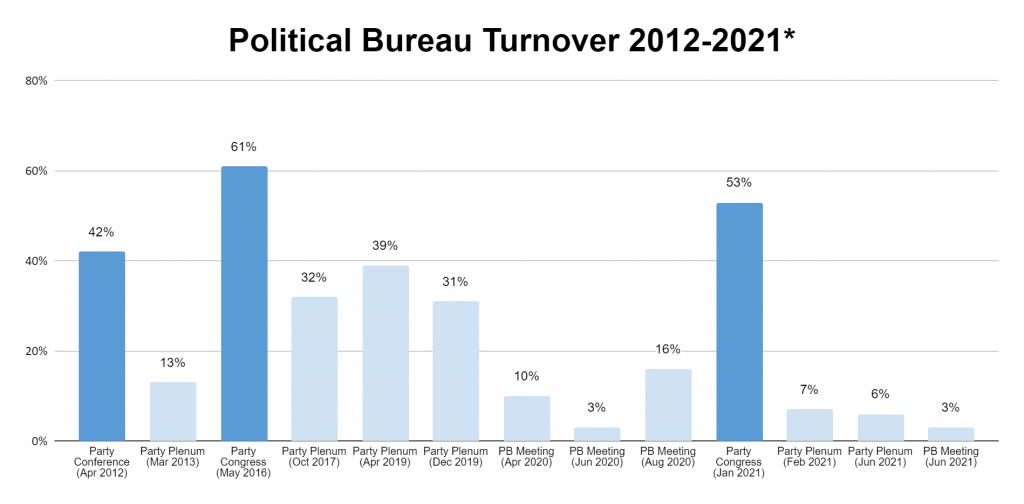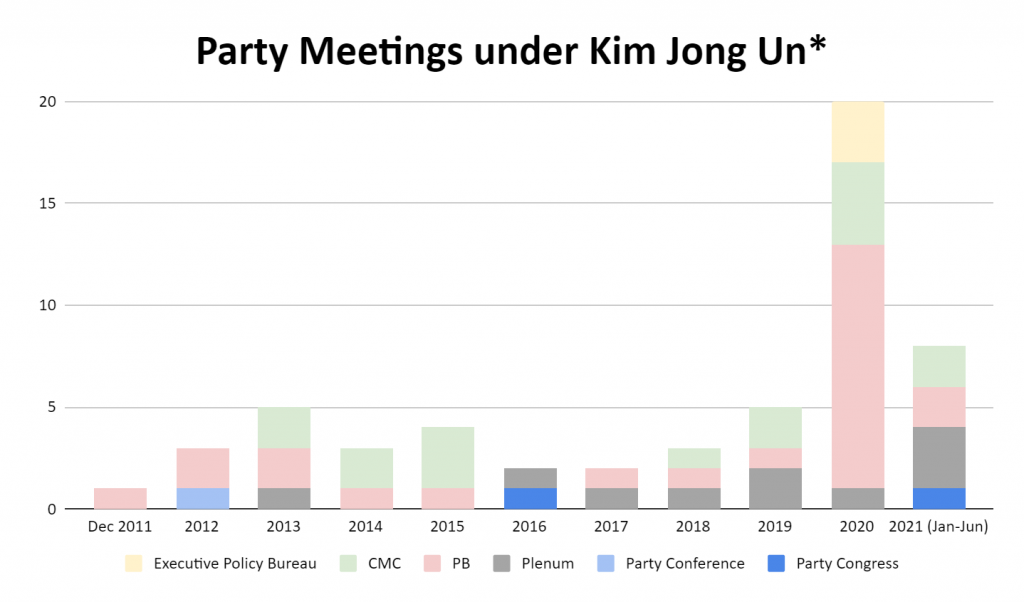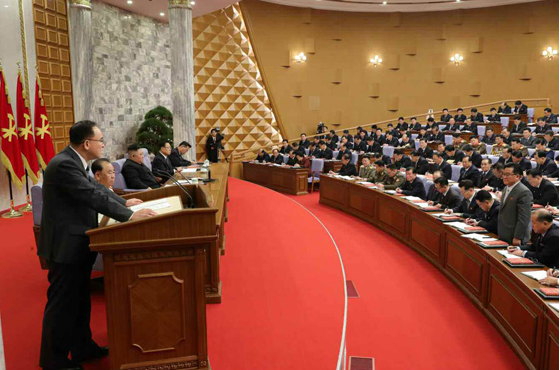North Korea’s Party Personnel Shuffles: A Reality Check
What is going on in North Korea? North Korea’s already-fragile economy is ailing as the national lockdown against the novel coronavirus (COVID-19) continues. Add to that low crop yields after flood damage last fall, causing Kim Jong Un to warn of food shortages during this lean season.[1] In June, Kim mentioned a “great crisis” in connection with national security and the people’s safety, which he followed up with yet another round of high-level personnel moves in the party—the third of their kind since the large-scale personnel shifts at the Eighth Party Congress in January.[2]
The North Korean party’s unusually extensive, back-to-back, high-level personnel shuffles since early 2020 owe to an unprecedented series of party meetings, at least going back to Kim Jong Il’s time. Kim seems to have viewed further institutionalization of the party leadership as key to resolving domestic issues. As a result, he convened a series of party meetings—the party leadership’s collective discussion and decision-making platforms—to improve performance and shake up party cadres. Such frequent high-profile personnel shifts not only send a signal to all functionaries that they, too, can be promoted or dismissed at any time depending on performance, but they also seem to demonstrate Kim’s confidence in managing the situation. Past examples suggest that the regime views larger-scale, publicly announced personnel moves as expanding control or demonstrating confidence in managing key players in the regime.
Overview of Personnel Shuffles
The chart below is a quantitative look at the turnovers in the Workers’ Party of Korea (WPK) Central Committee (CC) Political Bureau (PB, or Politburo) —a congregation of the regime’s highest-level party, state, and military and security officials—under Kim Jong Un for a sampling of top leadership shifts. Like all quantitative methods, this approach has its limits in that it overlooks the qualitative aspects, such as the nature or cause of each personnel change, but it is useful for seeing the broader trend over the years.

North Korea has conducted party personnel shuffles at an unusually high pace since early 2020, resulting in a 60 percent turnover in the Politburo in 2020 (including the December 2019 plenum), and roughly 70 percent of the Politburo newly elected or shuffled around in just the first half of 2021. The near-70 percent turnover in the first half of 2021 is not remarkable by itself: In January, North Korea held a Party Congress, where sweeping personnel changes are the norm. Top-level personnel shuffles between or even shortly after key party meetings also are not new in Kim Jong Un’s time. Many of them occurred quietly, though, without formal announcements, until a series of party meetings started being held in 2020.
Such extensive personnel changes at the top echelons of the party in two consecutive years are extraordinary. North Korea replaced 78 percent of the Politburo at the Third Party Conference in September 2010, and 42 percent more at the Fourth Party Conference in April 2012, but that was a major transition period from Kim Jong Il to Kim Jong Un.
The April 2019 plenary meeting predates the series of personnel shuffles, but it is also worth noting both for its relatively high turnover for a plenum and its timing. The move, made one month after the collapse of the Hanoi Summit, appears to have been aimed at revamping the party leadership as Kim geared up for longer-term hardships and a renewed self-reliance campaign that entailed stricter control across the political, economic and social realms.
Personnel Moves and Shifting Profile of Party Meetings
The frequency of North Korea’s high-level party personnel shifts since early 2020 should be viewed in connection with an extraordinary flurry of party meetings held during that same period. Approximately half of the 24 Politburo meetings and almost all of the 10 plenums held under Kim Jong Un that were reported by central media have dealt with personnel issues. Accordingly, the frequency of personnel shuffles started increasing in 2020.

As COVID-19 escalated into a global pandemic, Kim Jong Un kept the country’s borders sealed and remained focused on tackling issues at home. He seems to have viewed further institutionalization of the party leadership as key, giving greater responsibility to the party’s top cadres and playing up the party leadership’s collective discussion and decision-making. This did not mean an actual diminution in Kim’s status but rather a de-emphasis of his individual leadership and highlighting his role as the head of the party institution.
Accordingly, North Korea, since early 2020, has attempted to improve performance by shaking up the party and its functionaries at a series of party meetings, conducting personnel shuffles as needed, and sometimes calling out and dismissing specific cadres.[3] Besides the more obvious goals—sending a clear message that any official can and will be dismissed irrespective of one’s rank or title, and showing the general public that the WPK is doing its best to improve the people’s livelihood—such public high-level personnel actions seem to reflect the regime’s confidence in managing the situation.

Personnel Shuffles in a Historical Context
Larger-scale personnel changes alone, however, should not be assumed as a sign of instability in the Kim regime. The North Korean Politburo consistently recorded high turnovers in years of stability or major milestones in the Kim family’s succession campaign, suggesting that Pyongyang views personnel shuffles as expanding control or demonstrating confidence in handling key players in the regime.[4] For example, North Korea replaced 80 percent of the Political Committee (predecessor of the modern-day Politburo) at the 1970 Party Congress, held after Kim Il Sung purged his major political rivals and opponents in the 1950s and 1960s and the Kim regime entered a new period of cult of personality.[5] This marked a significant increase over the turnovers in party congresses from 1948 to 1961.
At the Sixth Party Congress in 1980, Kim Jong Il’s official coming-out venue, and at the Third Party Conference in September 2010, where Kim Jong Un made his public debut, the Kim regime replaced nearly 80 percent of the Politburo. At the Fourth Party Conference in April 2012, when Kim Jong Un’s leadership was in nascent stages, the young leader newly elected or promoted nearly half of the new Politburo leadership whom his father installed just 19 months earlier.
Similarly, on the military side, in the first couple years of his leadership, Kim Jong Un replaced ministers of the People’s Armed Forces and chiefs of the Korean People’s Army (KPA) General Staff with unusual alacrity, with some of them shuffled from one position to the other. Although these frequent shuffles raised the red flag at the time, they did not weaken Kim’s grip on power. Rather, they served to rein in the military, which had become too powerful as a result of Kim Jong Il’s military-first politics, and normalized the KPA as the army of the party.
Conclusion
Extensive or frequent personnel shuffles in North Korea tend to invite speculation about regime stability. It is important to remember, however, that personnel shifts have been part of the North Korean system for decades, and dismissals and recalls should not be equated with purges. A number of high-ranking officials have been in and out the door, shuffled about or experienced fluctuations in rank in Kim Jong Un’s time, both on the civilian and military sides.
It is also worth noting that North Korea carefully shapes and manages domestic and international public opinion through its media. When it conducts top-level personnel shuffles at highly publicized events like party meetings attended by Kim Jong Un, these shuffles are meant to be known and to send a message. So far, the one message that Pyongyang does not seem to be sending is that Kim Jong Un is facing regime stability issues.
- [1]
Political News Team, “3rd Plenary Meeting of 8th Central Committee of WPK Opens,” Rodong Sinmun, June 16, 2021, http://rodong.rep.kp/en/index.php?strPageID=SF01_02_01&newsID=2021-06-16-0002.
- [2]
Political News Team, “Report on Enlarged Meeting of 2nd Political Bureau of 8th C.C., WPK,” Rodong Sinmun, June 30, 2021, http://rodong.rep.kp/en/index.php?strPageID=SF01_02_01&newsID=2021-06-30-0002.
- [3]
For examples of personnel actions taken against specific party officials at party meetings, see Political News Team, “Enlarged Meeting of Political Bureau of C.C., WPK Held,” Rodong Sinmun, February 29, 2020, http://rodong.rep.kp/en/index.php?strPageID=SF01_02_01&newsID=2020-02-29-0001; and Political News Team, “Supreme Leader Kim Jong Un Convenes Enlarged Meeting of Executive Policy Council of C. C., WPK in Typhoon-hit Area before Inspection,” Rodong Sinmun, September 6, 2020, http://rodong.rep.kp/en/index.php?strPageID=SF01_02_01&newsID=2020-09-06-0003.
- [4]
Author’s tallies based on Rodong Sinmun’s coverage of the 1946, 1948, 1956, 1961, 1970 and 1980 party congresses and the 2010 and 2012 party conferences, and a listing of North Korea’s Politburo as of August 2010 in 정성장, 현대북한의 정치 역사, 이념, 권력체계 [The Contemporary North Korean Politics[:] History, Ideology and Power System] (Seoul: Hanul Academy, 2011), 293.
- [5]
Ibid, 85-91.
